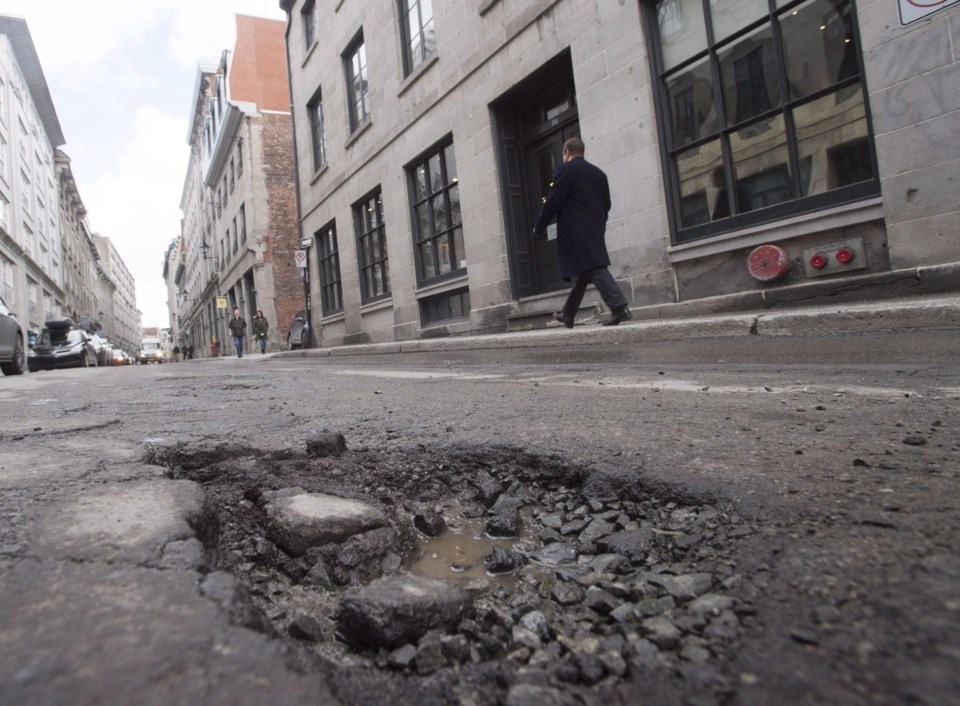TORONTO — For Mike Sanders, owner of Aaron's Taxi in Sudbury, Ont., bumpier routes have become an "unfortunate way of life."
Cities including his are reporting that a repeated cycle of freezing and thawing this spring has led to more potholes than usual on some Ontario roads.
"The biggest problem in Sudbury is so many of the main thoroughfares are bad," Sanders said in a recent interview.
Taxi drivers for his company usually drive major city roads dozens of times a day, often dipping into hard-to-see potholes in the curb lane. Sanders said it's taking a toll on his vehicles this year.
"You end up with a tremendous amount of damage to the components of the vehicle. The tires, rims, front end, rear end. It's unfortunate," he said.
"It's not helped by the fact that the quality of parts has declined to the point where they don't take much abuse anymore," Sanders added, explaining his fleet often uses after-market parts because they're more economical.
Officials across multiple cities explained that potholes are created more frequently in the spring, and most often after multiple periods of freezing and thawing like the province has seen this year.
During a thaw, water can seep through cracks in the road. It expands when it freezes and puts upward pressure on parts of the pavement. As vehicles drive over those areas, their weight can cause breakage, forcing asphalt out and creating craters in the ground.
Dan Thibeault, director of linear infrastructure with Greater Sudbury, said the city has filled "a higher than average" number of potholes so far in 2025.
Thibeault explained the city saw 14 cycles of freezing and thawing in March alone. He said the city also used salt on the roads — which melt ice and snow, letting more moisture seep into the roads — 26 out of 31 days this March. That's up from 16 days in 2024.
Sudbury isn't the only city in Ontario to see more potholes this season.
Data from the City of Toronto show workers had filled more than 108,136 potholes in 2025 as of Wednesday. The city filled 95,298 potholes during the same time frame in 2024.
Vincent Sferrazza, director of operations and maintenance for Toronto's transportation services, credits several freeze and thaw cycles for this year's pothole boom.
He said the city has recently made a "more concerted effort" to be proactive in filling gaps in the road before potholes are reported.
"We have dedicated crews and we have purchased more equipment for the specific purpose of repairing potholes," Sferrazza said in an interview.
A crew of about 250 extra people work from early November through mid-April on road operations, he said, which includes filling potholes.
Sferrazza said his crews prioritize neighbourhoods where there are more seniors, newcomers to Canada, people with disabilities and higher volumes of cyclists and pedestrians.
He said the city tries to hedge against the possibility that some groups are less familiar with the 311 system and may not report needed road repairs.
This year, potholes are the top reason people are nominating their local roads for the Canadian Automobile Association's annual "Worst Roads" campaign in Ontario.
Nominations don't close until Friday, but Teresa Di Felice, an assistant vice-president with the group, said 83 per cent of nominations are attributed to potholes.
"They're really driving this year's activity," Di Felice said.
She added that Hamilton's Barton Street East is a top contender for this year's title. The street was named Ontario's worst road in 2022 and 2023 because of persistent issues with potholes.
Di Felice said potholes are a "significant issue" for drivers because of the damage they can cause.
"If they didn’t realize (there were potholes on the roads), it could damage their tires, their rims. It could impact your steering and alignment," she said.
"There's general wear and tear that happens over bad roads, but potholes in particular — if you aren't aware and then all of a sudden you're diving along and you hit a pothole at a pretty good speed, and a good sized pothole … damages can range from anywhere from $500 to $2,000."
This report by The Canadian Press was first published April 17, 2025.
Cassidy McMackon, The Canadian Press


